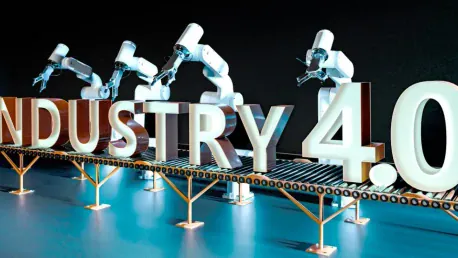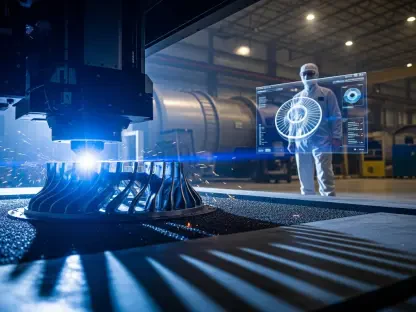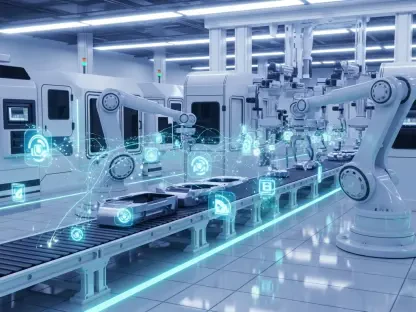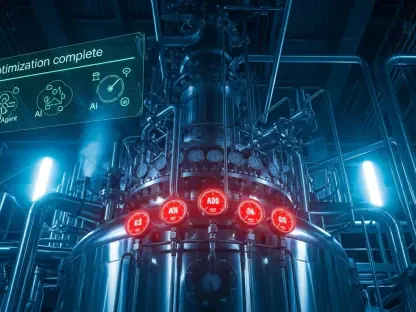Agentic AI is at the forefront of a major transformation in the manufacturing and supply chain industry. This technology is helping industries transition to smarter, more autonomous systems and is set to redefine future manufacturing processes. Agentic AI brings numerous advantages, including enhanced efficiency, cost savings, and sustainable practices, ensuring that the industry remains competitive and innovative.
Historical Context
From Steam Engines to Industry 4.0
The journey of automation in manufacturing began with the steam engines of the Industrial Revolution and has advanced considerably to today’s sophisticated systems. Historical advancements have paved the way for the current era, marked by continuous innovation and efficiency improvements. The initial adoption of steam engines dramatically increased production capabilities, laying the foundation for the mechanization of various manufacturing processes. Over the decades, technological evolution gradually led to more complex and efficient machinery.
As the years progressed, the shift from mechanical automation to electronic systems marked a significant leap. The introduction of programmable logic controllers (PLCs) and computer numerical control (CNC) machines further revolutionized manufacturing automation. These systems allowed for precise control and customization, essential for high-quality production. With the dawn of the internet and digital technologies, manufacturing entered a new era of interconnectedness and data-driven decision-making.
Evolution of Technology
The introduction of the internet led to significant changes in logistics through real-time tracking and data analytics, paving the way for increased efficiency. The ability to monitor and manage supply chains in real-time allowed companies to optimize their operations, reduce costs, and improve customer satisfaction. This period saw the birth of smart logistics, enabling businesses to respond quickly to changes in demand and supply conditions.
As data analytics capabilities grew, companies began to embrace big data technologies, transforming vast amounts of information into actionable insights. This shift enabled predictive analytics, helping businesses foresee market trends and adjust their strategies accordingly. Consequently, the digital transformation of logistics marked a crucial step towards the development of Industry 4.0, characterized by the integration of digital, physical, and biological technologies into manufacturing processes.
Intelligent Automation in Modern Manufacturing
Integration of IoT, AI, and Big Data
Industry 4.0 represents an era defined by the amalgamation of digital, physical, and biological technologies, creating smart factories where machines autonomously optimize production. The Internet of Things (IoT) plays a pivotal role by enabling devices to communicate seamlessly, fostering enhanced coordination and efficiency. In these smart factories, interconnected devices and systems collaborate in real-time to streamline processes, reduce downtime, and maximize productivity.
Artificial intelligence (AI) and big data analytics complement IoT by providing the intelligence needed for autonomous decision-making. AI-driven algorithms analyze vast datasets to identify patterns and trends, facilitating real-time optimization of production parameters. This integration creates a highly responsive manufacturing environment capable of adapting to changing conditions and demands. The ability to merge and analyze data from multiple sources enables a holistic view of operations, leading to more informed and timely decisions.
Introduction of Agentic AI
Agentic AI brings autonomous decision-making and real-time adaptability to the table, significantly enhancing efficiency and sustainability in manufacturing processes. Unlike traditional automation systems, agentic AI possesses the capability to learn, adapt, and make decisions independently. This advanced form of AI leverages machine learning and robotics to perform complex tasks, continuously improving and evolving based on real-world experiences. By autonomously managing processes and operations, agentic AI reduces the need for human intervention, resulting in lower operational costs and fewer errors.
Moreover, agentic AI promotes sustainable practices by optimizing resource utilization and minimizing waste. The technology can adjust production schedules and parameters to align with energy efficiency and sustainability goals. For example, agentic AI can detect inefficiencies in energy consumption and adjust machinery settings to reduce power usage without compromising output quality. This level of adaptability and intelligence is crucial for creating a more sustainable and environmentally friendly manufacturing landscape.
Applications of Agentic AI
Predictive Maintenance
In predictive maintenance, agentic AI continuously monitors machinery to foresee and prevent potential issues, thus saving costs and improving operational efficiencies. Traditional maintenance methods typically involve routine checks or repairing equipment after a failure occurs, which can lead to costly downtime and unexpected expenses. In contrast, predictive maintenance uses sensors and AI algorithms to monitor the condition of machinery in real-time, detecting signs of wear and potential failures before they become critical.
By analyzing data from various sensors and performance metrics, agentic AI predicts when and where maintenance is needed, allowing for timely interventions. This proactive approach extends the lifespan of equipment, reduces the likelihood of breakdowns, and optimizes maintenance schedules. Manufacturers benefit from fewer disruptions, lower maintenance costs, and improved overall efficiency. In addition, predictive maintenance supports sustainability by reducing the need for replacement parts and minimizing waste.
Optimized Inventory Management
Agentic AI utilizes real-time data for accurate demand forecasts, optimizing stock levels, and reducing carrying costs without disrupting production schedules. Inventory management is a crucial aspect of manufacturing, as both overstocking and understocking can have detrimental effects. Overstocking ties up capital, increases storage costs, and risks obsolescence, while understocking can lead to production delays and lost sales. Agentic AI addresses these challenges by analyzing historical data, market trends, and real-time demand signals to predict inventory needs accurately.
With this information, agentic AI can autonomously adjust inventory levels to ensure that raw materials and finished products are available when needed, without excess. This optimization leads to leaner inventories, lower carrying costs, and more efficient use of storage space. Furthermore, by avoiding stockouts, manufacturers can maintain steady production flows, meet customer demands promptly, and improve overall supply chain resilience. The ability to balance supply and demand dynamically also contributes to better financial performance and competitive advantage.
Dynamic Robotic Assembly
AI-powered robots can dynamically adapt to changing tasks in real-time, minimizing errors, optimizing resources, and ensuring scalable production. Traditional robotic assembly lines operate based on predefined instructions, limiting their flexibility and adaptability. However, agentic AI enables robots to learn from their environment, modify their actions accordingly, and perform a diverse range of tasks. This dynamic capability is transformative in manufacturing settings where product variations and customizations are frequent.
AI-powered robots equipped with machine learning algorithms can handle complex assemblies, adjust to new designs, and quickly adapt to changes in production requirements. This adaptability enhances the quality and consistency of production while reducing the incidence of errors and defects. Additionally, dynamic robotic assembly allows for greater scalability, enabling manufacturers to ramp up or down production volumes swiftly in response to market demands. As a result, manufacturers benefit from increased productivity, higher product quality, and improved customer satisfaction.
Human-AI Collaboration
Enhancing Human Roles
The implementation of agentic AI aims to transform human roles from repetitive tasks to more strategic decision-making positions, leveraging human creativity and problem-solving abilities. Automation often raises concerns about job displacement, but agentic AI focuses on augmenting, rather than replacing, human capabilities. By automating routine and labor-intensive tasks, AI frees up human workers to concentrate on more critical and value-added activities. In roles such as manufacturing planning, business operations, analysis, and reporting, human expertise remains indispensable.
With agentic AI managing mundane tasks, employees can focus on areas requiring creativity, strategic thinking, and complex problem-solving. This shift enhances job satisfaction and fosters a more innovative and adaptive workforce. For instance, human workers can collaborate with AI systems to optimize production workflows, develop new products, and improve operational efficiency. The synergy between AI and human intelligence creates a more dynamic and responsive manufacturing environment.
Reallocating Human Resources
By automating time-intensive tasks, human workers can focus on areas such as manufacturing planning and business operations, enhancing overall productivity. The recalibration of human roles facilitates a more efficient allocation of resources, ensuring that the workforce’s skills and talents are fully utilized. Employees can engage in continuous improvement initiatives, quality control, and process optimization, all of which are critical to maintaining competitive edge and operational excellence.
Moreover, the integration of agentic AI enhances employee training and development opportunities. Workers can acquire new skills related to AI and automation technologies, preparing them for the evolving demands of the manufacturing industry. Investing in workforce development ensures that employees are equipped to collaborate effectively with AI systems and contribute to the company’s long-term success. The combined efforts of human expertise and AI capabilities drive innovation, efficiency, and growth.
Advanced Software Solutions
Beyond Just a Service
The shift towards viewing software as an integral component of business processes highlights the importance of agentic automated decision-making for tailored and responsive manufacturing solutions. Traditionally, software has been perceived primarily as a tool to support various business functions. However, the advent of agentic AI transforms software into a strategic asset that actively participates in decision-making. These advanced solutions are designed to adapt to the specific needs of manufacturing operations, offering customized and integrated functionalities.
Agentic AI-driven software can analyze complex datasets, identify optimization opportunities, and execute decisions autonomously, ensuring that manufacturing processes are continuously improved. This capability allows manufacturers to respond quickly to changing market conditions, demand fluctuations, and operational challenges. Furthermore, software’s ability to self-optimize and learn from historical data contributes to sustained improvements in efficiency, productivity, and cost-effectiveness.
Digital Twins in Manufacturing
Digital twins provide real-time monitoring, predictive maintenance, and operational optimization by creating virtual models of physical systems. A digital twin is a precise, digital replica of a physical entity or system, continuously updated with data from sensors and other sources. In the manufacturing context, digital twins of production lines, machinery, or entire factories enable detailed simulations and analyses. These virtual models offer insights into performance, potential failures, and areas for improvement.
For example, a digital twin of a manufacturing plant can help identify bottlenecks, test new workflow configurations, and predict equipment degradation. Manufacturers can simulate various scenarios to determine the most efficient strategies before implementing changes in the physical environment. This approach minimizes risks, reduces trial-and-error iterations, and accelerates innovation cycles. In sectors such as aerospace and automotive manufacturing, digital twins are instrumental in optimizing complex and high-stakes production processes.
Amplified Benefits with Agentic AI
Combining digital twins with agentic AI enables enhanced autonomous decision-making, optimizing factors like energy efficiency and machinery longevity. Agentic AI leverages the vast amounts of data generated by digital twins to make real-time adjustments and improvements. For instance, AI can analyze a digital twin’s data to optimize production parameters, reduce energy consumption, and extend equipment life. This synergy results in smarter, more responsive manufacturing systems that can adapt to dynamic conditions.
The integration of digital twins and agentic AI also enhances predictive maintenance and operational planning. By continuously monitoring virtual models, AI can forecast potential issues and optimize maintenance schedules, reducing downtime and increasing uptime. Moreover, the ability to simulate various operating conditions and their impacts allows for proactive adjustments, ensuring optimal performance. This powerful combination drives significant advancements in manufacturing efficiency, sustainability, and resilience.
The Road Ahead
Limitless Potential
The future of manufacturing is poised for unprecedented customization, sustainability, and innovation, driven by intelligent automation and agentic AI. These technologies enable manufacturers to create highly flexible and responsive production environments tailored to specific market demands. As a result, companies can offer customized products, improve customer satisfaction, and build stronger competitive advantages. The focus on sustainability also ensures that manufacturing processes are environmentally friendly and resource-efficient.
Intelligent automation and agentic AI promote a collaborative approach where technology and human expertise coexist, driving continuous improvement and innovation. The ability to collect and analyze vast datasets in real-time supports informed decision-making and agile responses to market dynamics. Manufacturers can explore new business models, optimize existing operations, and develop cutting-edge solutions that meet evolving industry standards and regulations.
Forecast for 2025
Agentic AI is leading a significant shift in the manufacturing and supply chain sectors. This advanced technology is pivotal in guiding industries toward smarter, more autonomous operations, promising to reshape future manufacturing processes comprehensively. Agentic AI brings a wealth of benefits, including improved efficiency, substantial cost reductions, and the promotion of sustainable practices. Such advancements are essential for ensuring that the industry maintains its competitive edge and continues to innovate.
Furthermore, Agentic AI’s impact stretches beyond just automation; it actively assists in decision-making processes, enhances quality control, and optimizes production schedules, all of which contribute to a more streamlined and adaptive manufacturing environment. By leveraging big data and machine learning algorithms, Agentic AI can predict maintenance needs, reduce downtime, and improve overall productivity. Consequently, businesses adopting this technology can expect to see a significant return on investment while paving the way for a more sustainable and forward-thinking industrial landscape.









